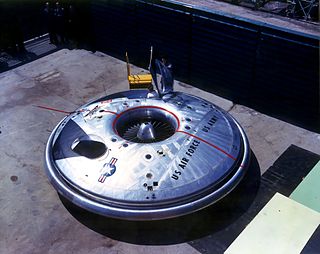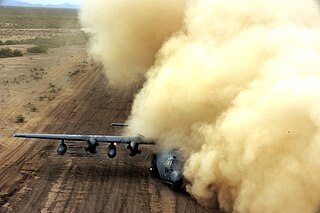
The CN Tower is a 553.3 m-high (1,815.3 ft) concrete communications and observation tower located in the downtown core of Toronto, Ontario, Canada. Built on the former Railway Lands, it was completed in 1976. Its name "CN" originally referred to Canadian National, the railway company that built the tower. Following the railway's decision to divest non-core freight railway assets prior to the company's privatization in 1995, it transferred the tower to the Canada Lands Company, a federal Crown corporation responsible for real estate development.

A flying car or roadable aircraft is a type of vehicle which can function as both a personal car and an aircraft. As used here, this includes vehicles which drive as motorcycles when on the road. The term "flying car" is also sometimes used to include hovercars.
In aviation, visual flight rules (VFR) are a set of regulations under which a pilot operates an aircraft in weather conditions generally clear enough to allow the pilot to see where the aircraft is going. Specifically, the weather must be better than basic VFR weather minima, i.e. in visual meteorological conditions (VMC), as specified in the rules of the relevant aviation authority. The pilot must be able to operate the aircraft with visual reference to the ground, and by visually avoiding obstructions and other aircraft.

An airport is an aerodrome with extended facilities, mostly for commercial air transport. Airports often have facilities to park and maintain aircraft, and a control tower. An airport consists of a landing area, which comprises an aerially accessible open space including at least one operationally active surface such as a runway for a plane to take off and to land or a helipad, and often includes adjacent utility buildings such as control towers, hangars and terminals. Larger airports may have airport aprons, taxiway bridges, air traffic control centres, passenger facilities such as restaurants and lounges, and emergency services. In some countries, the US in particular, airports also typically have one or more fixed-base operators, serving general aviation.
For fixed-wing aircraft, ground effect is the reduced aerodynamic drag that an aircraft's wings generate when they are close to a fixed surface. Reduced drag when in ground effect during takeoff can cause the aircraft to "float" whilst below the recommended climb speed. The pilot can then fly just above the runway while the aircraft accelerates in ground effect until a safe climb speed is reached.

Air Canada Flight 143, commonly known as the Gimli Glider, was a Canadian scheduled domestic passenger flight between Montreal and Edmonton that ran out of fuel on July 23, 1983, at an altitude of 41,000 feet (12,500 m), midway through the flight. The flight crew successfully glided the Boeing 767 to an emergency landing that resulted in no serious injuries to passengers or persons on the ground, at a former Royal Canadian Air Force base in Gimli, Manitoba, that had been converted to a motor racing track. This unusual aviation incident earned the aircraft the nickname "Gimli Glider". The accident is commonly blamed on mistaking pounds for kilograms, which resulted in the aircraft carrying only 45% of its required fuel load. However, the units error was the last in a series of failures that aligned in a Swiss cheese model to cause the accident.

Taxiing is the movement of an aircraft on the ground, under its own power, in contrast to towing or pushback where the aircraft is moved by a tug. The aircraft usually moves on wheels, but the term also includes aircraft with skis or floats.

A heliport, helidrome or rotor station is a small airport suitable for use by helicopters and some other vertical lift aircraft. Designated heliports typically contain one or more touchdown and liftoff areas and may also have limited facilities such as fuel or hangars. In some larger towns and cities, customs facilities may also be available.
This glossary of wildfire terms is a list of definitions of terms and concepts relevant to wildfires and wildland firefighting. Except where noted, terms have largely been sourced from a 1998 Fireline Handbook transcribed for a Conflict 21 counter-terrorism studies website by the Air National Guard.

The vortex ring state (VRS) is a dangerous aerodynamic condition that may arise in helicopter flight, when a vortex ring system engulfs the rotor causing severe loss of lift. Vortex ring state is sometimes referred to as settling with power, though the latter is also a terminology variously used for low-RPM states caused by rapid increases in collective resulting in over-pitching of the main rotor blades and/or from exceeding engine capability during rapid deceleration and/or descent. The Federal Aviation Administration (FAA) sees these terms as synonymous, whereas Transport Canada sees them as two different phenomena.

The Avro Canada VZ-9 Avrocar was a VTOL aircraft developed by Avro Canada as part of a secret U.S. military project carried out in the early years of the Cold War. The Avrocar intended to exploit the Coandă effect to provide lift and thrust from a single "turborotor" blowing exhaust out of the rim of the disk-shaped aircraft. In the air, it would have resembled a flying saucer.

Ground support equipment (GSE) is the support equipment found at an airport, usually on the apron, the servicing area by the terminal. This equipment is used to service the aircraft between flights. As the name suggests, ground support equipment is there to support the operations of aircraft whilst on the ground. The role of this equipment generally involves ground power operations, aircraft mobility, and cargo/passenger loading operations.

A helicopter is a type of rotorcraft in which lift and thrust are supplied by horizontally-spinning rotors. This allows the helicopter to take off and land vertically, to hover, and to fly forward, backward and laterally. These attributes allow helicopters to be used in congested or isolated areas where fixed-wing aircraft and many forms of VTOL aircraft cannot perform.

In aviation, a brownout is an in-flight visibility restriction due to dust or sand in the air. In a brownout, the pilot cannot see nearby objects which provide the outside visual references necessary to control the aircraft near the ground. This can cause spatial disorientation and loss of situational awareness leading to an accident. Pilots have compared landing during brownouts to parallel parking an automobile with one's eyes closed.

The Helicopter Flight Rescue System (HFRS), also known as the Helicopter External Transport System (HETS), is a helicopter insertion and extraction tool which as under the Canadian Aviation Regulations (CARs) is authorized for use in Forest Fire Fighting, Law Enforcement, and Search and Rescue. The system is often referred to as "Long Line", "Short Haul", and other terms, and is similar to other helicopter long line systems in use throughout the world.

Air medical services is a comprehensive term covering the use of air transportation, aeroplane or helicopter, to move patients to and from healthcare facilities and accident scenes. Personnel provide comprehensive prehospital and emergency and critical care to all types of patients during aeromedical evacuation or rescue operations aboard helicopter and propeller aircraft or jet aircraft.

On 16 January 2013, an Agusta A109 helicopter crashed in Vauxhall, London, after it collided with the jib of a construction crane attached to St George Wharf Tower. Two people died in the incident: the pilot, Pete Barnes, 50, and a pedestrian, Matthew Wood, 39, from Sutton in south London. Five people were taken to hospital and seven more were treated at the scene.
The TechHaus Volantis is an American electric-powered hover vehicle commissioned by pop star Lady Gaga as a "flying dress" in support of her 2013 album Artpop.
The Space Shuttle recovery convoy was a fleet of ground vehicles, many of which were specially-designed for their purpose, staged at the landing site of a Space Shuttle orbiter which assist the crew in egress and safe the vehicle and its payload after landing. Some vehicles and equipment which were very specific to the shuttle program were retired and either sold at auction or transferred to museums for public display. The majority of convoy vehicles were stored in buildings near the Shuttle Landing Facility.

On March 11, 2018, a sightseeing helicopter crashed into the East River off the Upper East Side of Manhattan, New York City, killing 5 people. Two passengers died at the scene, and three others were pronounced dead at the hospital. The pilot escaped the helicopter following the crash. The aircraft was operated by Liberty Helicopters for FlyNyon. Two people were from New York state; another two were from Dallas, Texas; and the fifth was from Argentina. The pilot is from Connecticut.















